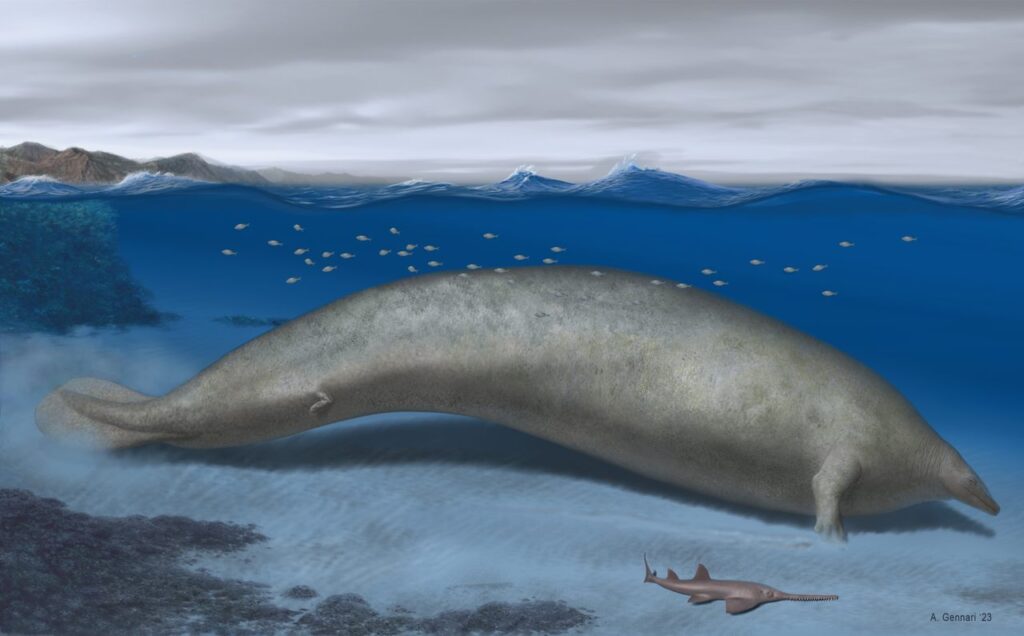Aug
27
“Chonky” Whale May Have Been World’s Heaviest
“The authors have definitely found something new. This is a really weird, stupendously large, early whale.” — paleobiologist Nicholas Pyenson, curator of fossil marine mammals at the Smithsonian National Museum of Natural History
Thirteen years after paleontologist Mario Urbina discovered some really big fossils in the coastal desert of Peru, he and his team were finally able to publish their findings in Nature. Based on dating of volcanic ash at the site, this new species of early whale, dubbed Perucetus colossus, is roughly 39 million years old — “far earlier in history than scientists would expect, changing the known evolutionary timeline for huge whales up by 30 million years.” (Note: I will not be commenting on the evolutionary assumptions, etc.)

Perhaps equally exciting is that, while shorter than the blue whale, its skeleton would have weighed even more.
“At 66 feet in length, the colossus isn’t the biggest or longest creature to have lived in the seas, since blue whales can grow to a gargantuan 100 feet long. But [the newly discovered sea mammal] was probably the heaviest and could have weighed between 94 tons (85 metric tons) and 375 tons (340 metric tons), the study said. The biggest blue whales ever observed weigh an estimated 200 tons (180 metric tons).”
As someone else put it, “At the upper range, that’s more than twice as chonky as a blue whale.”
This is because the bones of P. colossus are extremely dense, even in contrast to other huge cetaceans. A condition called pachyostosis formed an extra layer of bone on the skeleton’s outer surface, while osteosclerosis resulted in the inner cavities being filled with compact bone. As with manatees, this allowed the creatures to control their buoyancy.
The sheer size of the fossils in question were a big part of why it took so long to excavate, study, and get the paper out.
“The preserved bones have taken over a decade to excavate from a 100-foot hill. Each field campaign could only transport two of the massive vertebrae, says [Rodolfo] Salas-Gismondi; at the end of 13 years of work, 13 have been recovered, each 220 pounds, along with four ribs, each over four feet long, and a hip bone.”
Note that they haven’t found any skull fragments, and the relatively tiny head seen in reconstruction paintings like the one above is just a guess. Absence of a skull makes Pyenson reluctant to speculate on the creature’s overall size and weight.
“Length estimates are more reliably reconstructed from incomplete material. What is much harder is weight. I am skeptical of some of the larger size estimates because they place it in a body size category for which we have no comparison.”
Continuing to look for the head is a priority for the international team. In addition to matters of length, weight, and overall size, they are hoping for clues about diet and feeding strategies. (How the heck does a mammal that size feed itself, especially in shallow coastal waters?!)
I’ll just finish up with an excerpt from the paper’s abstract:
“[H]itherto known gigantism among aquatic tetrapods evolved within pelagic, active swimmers. Here we describe Perucetus colossus — a basilosaurid whale from the middle Eocene epoch of Peru. It displays, to our knowledge, the highest degree of bone mass increase known to date, an adaptation associated with shallow diving. The estimated skeletal mass of P. colossus exceeds that of any known mammal or aquatic vertebrate. We show that the bone structure specializations of aquatic mammals are reflected in the scaling of skeletal fraction (skeletal mass versus whole-body mass) across the entire disparity of amniotes. We use the skeletal fraction to estimate the body mass of P. colossus, which proves to be a contender for the title of heaviest animal on record.”
Somebody get the Guinness Book on the horn!
P.S. If you want to see any of these huge fossils on display, you’ll have to travel to the Museum of Natural History in Lima.















